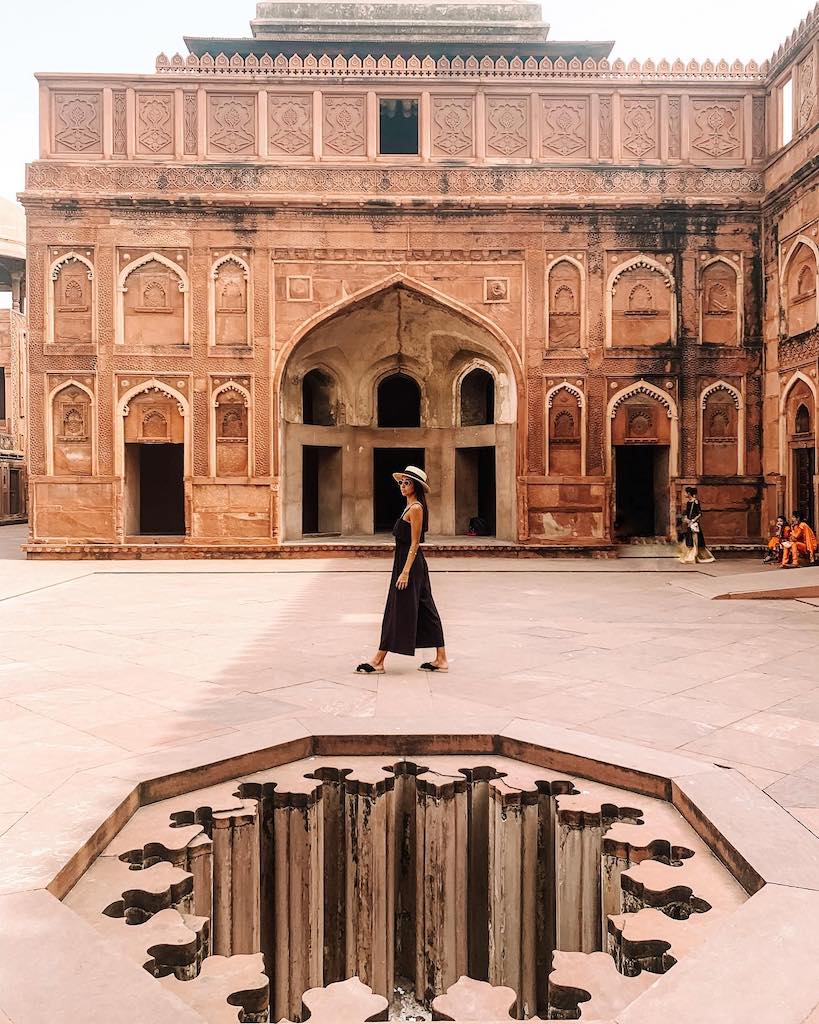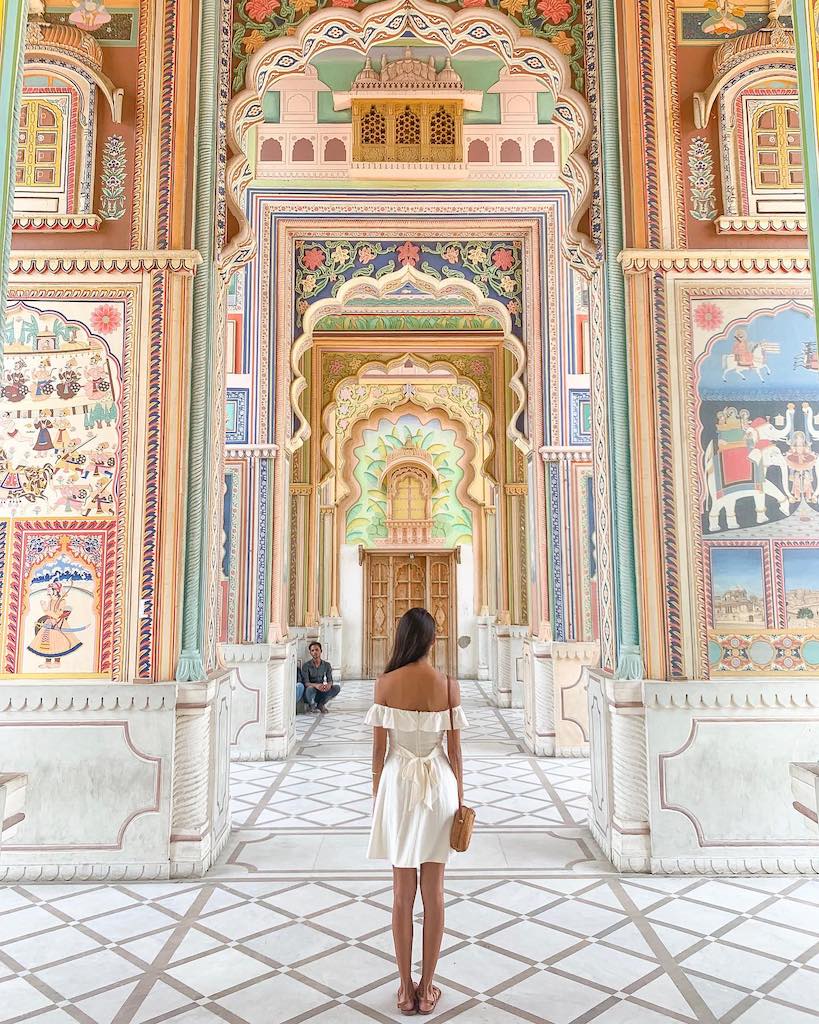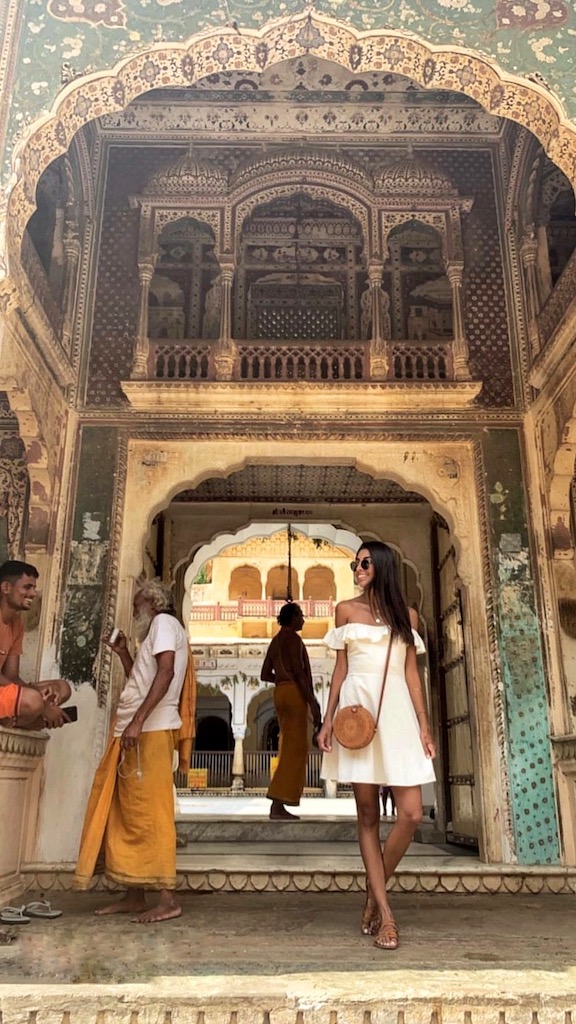
The Golden Triangle of India, also known as Delhi-Agra-Jaipur, is one of the most visited routes in the country.
If you’re looking for a comprehensive taste of India’s highlights, I recommend exploring the Golden Triangle, which showcases some of the country’s best attractions.
In this Golden Triangle India itinerary, you will find the best ways to get around the city, top attractions, accommodation options, and some helpful tips.
Let’s get started!
What is the Golden Triangle?
Located in North India, the Golden Triangle comprises three cities: Delhi, Agra, and Jaipur.
They are referred to as the “Golden Triangle” because their locations form a triangle on the map, and they are recognized as significant centers of Indian history and culture, earning them the title of ‘golden’ cities.
The Golden Triangle itinerary is an excellent choice for first time visitors to India, it will allow you to witness the main highlights and immerse yourself in the rich cultural and historical heritage of the country.
How many days do I need in the Golden Triangle?
Traveling the Golden Triangle is one of the best trips to take if you have limited time in India. It can be completed in as little as 5 days (2 days in Jaipur, 1 day in Agra, 2 days in Delhi).
However, in my opinion, the ideal duration for the Golden Triangle itinerary is 10 days. If you have more time available, even better, as you can indulge in additional activities or consider adding another destination such as Varanasi or Rajasthan.
How to get around the Golden Triangle?
By bus
There are regular bus services connecting the three major cities—Delhi, Agra, and Jaipur—and they’re an affordable way to travel around the Golden Triangle. Plus, they give you a chance to see different parts of India along the way. You can easily book tickets online through travel websites like RedBus.
Note that the quality of buses can vary significantly. Some services may be basic, while others offer more comfortable, air-conditioned options. So, it’s a good idea to research your options in advance to ensure a comfortable ride.
By train
Traveling by train is the preferred means of transportation for both locals and visitors. The Golden Triangle route is super popular, so you’ll find many options available. The route goes like this: Delhi to Agra, Agra to Jaipur, and then Jaipur back to Delhi.
It’s a good idea to book your train tickets in advance through the official railway website, since the trains can get pretty crowded. And if you’d rather not deal with the hassle, there are travel companies that offer packaged tours that include train tickets.
By car/taxi
Another option for getting around the Golden Tringle is hiring a private car or taxi. It’s more expensive than taking the bus or train, but to be honest, it’s not super costly compared to what it would be in other parts of the world. Plus, it gives you the flexibility to make stops along the way.
You can truly customize your own itinerary this way. India drivers are also very friendly and will be happy to share some history and recommendations during your trip.
I chose this mode of transportation for its practicality, comfort, and affordability. We hired a driver for the entire 10 days, which allowed us to move at our own pace and simplified everything for us. It was wonderful! And, even though it is more expensive than bus and train, it is still quite reasonable.
By flight
Flying is a fast and convenient way to do your Golden Triangle itinerary. Flights connect Delhi to both Agra and Jaipur, saving you a lot of travel time. While they’re pricier than trains or buses, they’re perfect if you’re short on time and want a more comfortable ride.
Designing Your Ideal 10 Days Golden Triangle India Itinerary

Delhi
The first stop on this Golden Triangle itinerary is Delhi, the historical capital city of India.
Delhi is a city that never slows down—it’s bustling with people, vibrant streets, colorful markets, and an endless mix of sights, sounds, and smells. From the historic monuments and museums to the busy bazaars and street food stalls, there’s always something happening around every corner. It’s a place where you can appreciate everything from its unique culture and rich history to its modern energy.
With so much to see and do, you’ll need plenty of time to properly explore. I’d recommend 5 days to really experience the best the city has to offer, with Day 1 being for arrival and settling into your hotel, and Day 5 for departure.
Delhi can be overwhelming at times, but it’s also incredibly exciting. The city’s energy and history come together in a way that’s unlike anywhere else in the world.
Top tip: Beware of fake guides! You can reach many of the tourist attractions on your own, or consider taking a guided tour with a reputable company.
Where to stay in Delhi
Delhi is one of the most popular cities in India, so there are many accommodation options, including hostels, hotels, private homes, and B&Bs. Guesthouses and hostels are the cheapest places to stay in Delhi.
I found that staying at a comfortable hotel at the end of the day greatly aided my recovery and provided much-needed relaxation. Opting for a higher-end hotel is also a good choice as the rates are better compared to other major cities around the world.
Best Things to Do in Delhi
Lotus Temple

Lotus Temple is a Baha’i House of Worship built in the shape of an actual lotus flower but in white. It’s open to everyone, especially those looking for serenity and solace during their time in Delhi.



Red Fort


Red Fort is a mind-blowing landmark in Delhi. It was built in 1648 by emperor Shah Jahan, and it showcases beautiful Persian and Mughal architecture. It’s the largest monument in Delhi and a UNESCO World Heritage Site.
It also hosts a nightly sound and light show, which tells the history of the fort, from its construction to its significance in India’s history. The show includes speeches from freedom fighters like Mahatma Gandhi and Jawaharlal Nehru. The Red Fort is a must-see in Delhi!



Safdarjung Tomb
Safdarjung Tomb was built in 1754 and is the last garden tomb built in the style of the late Mughal Empire. The tomb is made of marble and sandstone and is surrounded by well-maintained gardens.
Safdarjung tomb also boasts pretty lawns, fountains, a well canal, and high carved ceilings with Arabic inscriptions. It is not as crowded or popular as other monuments, but it’s a special place for those who add it to their itinerary.



Humayun Tomb

This is one of the most important monuments in India, a UNESCO World Heritage Site, and the resting place of Emperor Humayun.
Humayun’s Tomb is the first garden tomb in India, with an exceptionally manicured garden all around. This tomb combines Persian and Indian designs and has inspired many architectural structures in the country, including the Taj Mahal!



India Gate

One of the best things to add to your India’s Golden Triangle itinerary is a walk around India Gate.
India Gate was built in 1931 to commemorate the death of the 82,000 soldiers of India’s army. This site has a sprawling garden, beautiful scenery, and an ‘eternal’ flame.
It’s a perfect spot to stroll, sit, and take in the scene. There are stalls where you can get snacks to munch while taking in the surroundings.
The best time to visit is in the evening, specifically from 7pm to 10pm, when the light show takes place and the gate is beautifully illuminated.



Agrasen Ki Baoli

This 60-meter-long, 15-meter-wide historical step well is one of the oldest monuments in central Delhi and one of the best places to visit.
It was originally built by the legendary king Agrasen and was constructed from uneven stones. This baoli has 103 steps with three levels of chambers and passages. Some people believe Agrasen Ki Baoli is haunted, and one legend says that demons hide in the walls.
This stepwell may have a creepy story, but there is no denying it’s a beautiful wonder worth visiting if you’re brave enough.


Qutub Minar

Qutub Minar is a tower of ancient Indian architecture. Standing at a height of 73 meters (239.5 ft), this UNESCO World Heritage Site is a magnificent example of the Indo-Islamic architectural style.
Built in the 12th century, it features unique architectural details with intricate carvings and inscriptions.


Gurudwara Bangla Sahib Temple

This Sikh temple is open to everyone, regardless of faith and religion. Like other temples, it is incredibly tranquil and peaceful.
There is a large reservoir of holy water where you can bathe with beautiful fishes. You will also find a community kitchen where you can volunteer to make meals for the congregation.
This might be the only time on your Golden Triangle India itinerary that you get to visit a Sikh temple, so I recommend you don’t skip it.


Jama Masjid

Jama Masjid is the largest mosque in India; it can hold up to 25,000 people. It isn’t just the size of the mosque that will amaze you, but also the stunning architecture, built in 1655.
You can climb the minaret to get beautiful views of the stacked rooftops, the twirling kites, and the vultures.


Exploring the center of the capital and Old Delhi

If you want to immerse yourself in local culture, I recommend you go on a street tour of Old Delhi.
You can enjoy street food, wander through the narrow bazaars, and keep an eye on the colorful Jain havelis built in the 18th century.
Agra

The second stop after New Delhi is Agra, the city that is home to the beautiful Taj Mahal, one of the most incredible man-made wonders of the world.
Agra was India’s capital under the Mughals and is now one of the most popular cities on visitors’ itineraries. I recommend you stay at least two days because the Taj Mahal alone deserves half of your day.
Try to book tickets for all the landmarks you will visit in Agra online before you arrive, and beware of people that offer to show you around. Agra from Delhi takes about 3.5 hours by road.
Where to stay in Agra
There is no shortage of hotels, guesthouses, and hostels in this city. Agra has different areas and neighborhoods to stay, but one of the most popular, especially amongst budget travelers, is Taj Ganj.
Best Things to Do in Agra
Agra Fort

Agra Fort is a magnificent Mughal fortress in Agra that used to be the home of emperors but is now a UNESCO World Heritage Site.
This fort is truly stunning with its red sandstone architecture and intricate carvings. You can explore its royal pavilions, mosques, courtyards, towers, and it even has a point where you can enjoy views of the Taj Mahal.
Lastly, there is a sound and light show known as the Mehtab Bagh Sound and Light Show. It’s held here after every sunset at Mehtab Bagh, which is a garden located across the Yamuna River from the fort.



Tomb of I’timād-ud-Daulah
I’timād-ud-Daulah is the tomb of a Persian nobleman. It features a beautiful display of gardens and architecture in Persian style.
I’timād-ud-Daulah is also close to the Yamuna River and serves as a great spot to enjoy the tranquil river views.


Taj Mahal


You’ve probably heard how beautiful the Taj Mahal is, but no description will prepare you for the spellbinding experience from coming face-to-face with it.
Emperor Shah Jahan built this awe-inspiring white marble monument in memory of his favorite wife, Mumtaz Mahal. The entrance is carved with Quranic verses, and the walls are decorated with beautiful precious and semi-precious stones.
While you are here, you can go to Mohabbat The Taj Show to watch the reenactment of the love story of Shah Jahan and his wife.
Being one of the seven wonders of the world, you can expect that the Taj Mahal gets countless visitors per day. If you want to avoid the crowds as much as possible, I advise you to arrive half an hour before opening time. This way, you can ensure that you are near the front of the queue.


Best viewing points for the Taj Mahal
Some of the best ways to enjoy the Taj Mahal are from viewing points, places such as: Agra Fort, taking a stroll through the Mehtab Bagh (the moonlight garden), and taking a Taj Mahal boat ride on the Yamuna River.
Jaipur

Our final spot on the Golden Triangle India Itinerary is Jaipur, a city full of many spectacles, great regional food, and world-class attractions.
Jaipur is one of the biggest cities in India, and it has a pink hue that has earned it the title of ‘Pink City.’ To cover the best of what this metropolis has to offer, I recommend you spend at least three days here.
The travel time from Agra to Jaipur is about 4.5 hours by road. There is also the option to take a domestic flight from the airport in Agra.
Where to stay in Jaipur
As one of the cities closest to Delhi, Jaipur is home to some of the best hotels, villas, ancient Havelis, palaces, hostels, and Airbnb’s.
The best areas to find accommodation options for all budgets are The Old City, Raja Park, and Bani Park.
Best Things to Do in Jaipur
Patrika Gate

A magnificent colorful structure that is adorned with Rajasthani motifs, intricate carvings, and stunning artwork that depict the essence of Rajasthan’s traditions and folklore. Its vibrant colors are sure to captivate you!
Patrika Gate serves as a beautiful gateway to the Pink City. Be prepared to capture some beautiful photos.



City Palace

City Palace is located in the center of Jaipur and has many beautiful gardens, courtyards, pavilions, temples, and buildings you can explore. It is the home of Jaipur’s royal family, and the buildings are a fusion of Rajput, Mughal, and European architecture.
Only a section of the palace is open to visitors, and this includes the Mubarak Mahal Museum, where you will find royal artifacts and clothing.



Hawa Mahal

Hawa Mahal, also known as the “Palace of Winds”, is an iconic landmark in Jaipur. It was built in 1799 as an extension of the City Palace of Jaipur. This stunning five-story red and pink palace building features more than 900 windows!
Hawa Mahal was designed for royal ladies to watch the festivals and outside life without going on the street. The building has a shape resembling Lord Krishna’s crown and gives off a golden glow if you visit early morning.
It’s a must-visit!



Walking tour around the old Pink City and its bazaars
Pink City has many masterpieces, architecture, and layout of bazaars. You should consider walking around the city to discover many of its hidden gems, vibrant markets, historic palaces, and stunning temples.
From the grandeur of the City Palace to the intricate carvings of the Hawa Mahal, there’s so much to explore and enjoy!
Also, you can visit the Jaipur bazaars to get all kinds of souvenirs, including clothes and jewelry, and relish local flavors at the stalls.
Amber Fort

This world heritage site provides incredible views of the city and features Indian-Muslim architecture that has made it a UNESCO World Heritage Site.
There are many beautiful palaces, gardens, and halls you can explore in this fort. Legend says that invaders found the Amer Fort so beautiful that they couldn’t dare to destroy it during the wartimes.
Amber fort also offers a light and sound show that brings the fort’s rich history to life through narrative and light effects. It typically starts around 6:30 PM to 7:00 PM in the fort’s courtyard (outside opening hours).



Panna Meena Ka Kund

Panna Meena Ka Kund is an ancient community center with octagonal gazebos, criss-cross stairs, and a well-preserved step well.
This monument is full of water all year round and used to be a water source for people in the past. Panna Meena ka Kund is an architectural delight where you can take some stunning photos!


Nahargarh Fort

Nahargarh Fort, aka Tiger Fort, was part of the defense wall around the cities of the old town. One of the most incredible features of this palace is the Madhavendra Bhawan, which has 13 identical suites so that it was easy for the Maharaja to visit any of the queen’s rooms without others finding out.
Nahargarh Fort is a great place to watch sunsets, enjoy stunning views, and experience the beauty of Jaipur from above.



GaltaJi Temple

This stunning temple embodies architectural brilliance, historical significance, and spiritual vibes. It has seven water tanks fed by a mountain spring, pilgrims bathe in it to wash away their sins.
You can enjoy the presence of monkeys, watch the sunset from Sun Temple, and hike up the GaltaJi trail.


If you’re ready to embark on your Golden Triangle India Itinerary, don’t forget to check out my comprehensive India packing list guide. It’s packed with tips and essentials to help you prepare for your journey and make the most of your trip!








Hello.
Can you let me know how you found your driver.
Did you book your own accommodation?
Was driver with you the whole time? Where does the driver sleep?
We are arriving in Delhi end of this month
regards
julie
Hi Julie,
Nice to connect with you!
A friend who is local helped us to arrange the driver. Sorry can’t help much with this, but I am sure you can easily arrange one (maybe even through the hotel?). It’s a very common service! We hired him for our entire stay, he came everywhere with us and he arranged his own accommodation.
Regarding our accommodation, we booked directly through sites like booking.com. We stayed at hotels that are well-known.
Wishing you a wonderful experience!